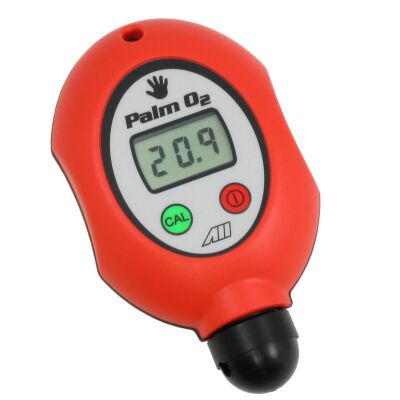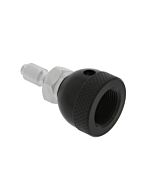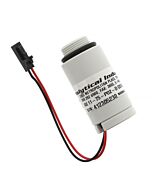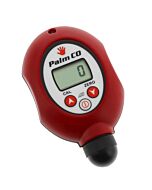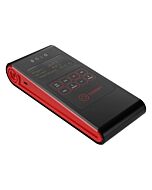Palm D Oxygen Analyzer
- Portable, accurate and affordable
- Durable sealed impact resistant housing
- One button calibration in either Air or 100% Oxygen
- User-replaceable Oxygen sensor maintains accuracy
- Sensor life up to 36 months for average personal use
Palm D Oxygen Analyzer
The Analytical Industries Palm D Oxygen Analyzer ("D" for their diving version of the Palm) is portable, accurate and affordable; and our customers tell us this unit is extremely easy to use. One button calibration in either air or 100% oxygen is exceptionally easy and the Palm D will analyze diving gases for oxygen content between 0% and 100%, with a resolution of 0.1% and response time of less than 6 seconds for sport nitrox mixtures. The user-replaceable thermally compensated sensor maintains accuracy levels that exceed dive industry standards. Just hold the Palm D directly to the cylinder valve outlet and crack open the valve slightly until the reading is stable; works with both Yoke and DIN valves with only one hand and no adapter needed! A blue tee adapter for optional use with a yoke valve is also included.
The Palm D Oxygen Analyzer comes complete with sensor and batteries installed, ready to use right out of the box. The durable impact resistant housing is sealed for excellent water resistance, includes an on/off switch and allows for user-replacement of the two 1.5V AA alkaline batteries with an approximate life of 13,000 hours of continuous use. Ergonomically designed to comfortably fit your hand, the Palm D offers a very compact form factor of { 2.7 in | 6.9 cm } wide by { 4.1 in | 10.4 cm } tall by { 1.4 in | 3.6 cm } deep and { 7 oz | 196 g } weight. With a user-replaceable oxygen sensor and sensor life of up to 36 months average for personal use, the AII Palm D Oxygen Analyzer is an excellent value solution for your long-term needs. NOTE: Hot and humid or extreme cold environments may shorten sensor life and/or battery life.
An optional 2 liter-per-minute flow sampling adapter for the standard BC inflator hose quick-release fitting is also available. The 2 liter-per-minute flow sampling adapter makes it easy to check your gas even after you have attached your regulator to your tank, and the consistent measured gas flow produces more repeatably accurate results. An optional padded storage bag is also available.
† The Palm D Oxygen Analyzer is designed to meet the requirements of oxygen measurements for the purposes of recreational diving applications. Best practice for the most accurate nitrox measurement is calibrating and sampling at 2 liter-per-minute flow using air for the intent of taking measurements of oxygen levels up to 40%, or using 100% oxygen as the calibration gas for the intent of taking measurements of oxygen levels 50% and above.
| Brand | Analytical Industries |
|---|---|
| SKU | ADI-PalmO2D |
| Weight | 1.000000 |
Customer Reviews
 WARNING
WARNING
Although tolerant of ordinary non-condensing humidity and water resistant, no analyzer is waterproof. Operation of any analyzer in boat spray, even brief immersion in water, or damp storage such as with wet dive gear may cause corrosion of the internal electronics or deposits on the face of the sensor. The result can be erratic operation such as error codes, battery warnings, or possibly inaccurate analysis readings without any indication of a fault. Always operate and store your analyzer in dry conditions, and if you suspect the analyzer has been exposed to wet conditions then discontinue use until the equipment has been serviced.
Our products are intended for use in SCUBA diving related applications; they are not intended for use in medical, aerospace, or industrial applications. Purchases for use in non-diving applications are not qualified for return or refund. We are not able to supply certificates of conformance to any specific requirements or specifications such as Mil-Spec, OSHA, ISO or CE standards.
YOU MAY ALSO BE INTERESTED IN THE FOLLOWING PRODUCT(S)
Calibrating Oxygen Analyzers for Diving
Analyzing oxygen requires the analyzer first be calibrated and that calibration requires a "known" gas. The gas most often used for calibration by sport Nitrox divers is Air, commonly described as 20.95% Oxygen. However, it's really not always 21%, in fact the Compressed Gas Association says Air can contain from 19.0% to 23.5% Oxygen and still be considered Air. Beyond the variation in actual gas composition, several other factors should be considered. Environmental factors such as barometric pressure and humidity, affected by both altitude and weather, will affect the calibration. Some inexpensive manually calibrated analyzers provide compensation charts to compute the calibration value. The most sophisticated analyzers will automatically measure several environmental factors to determine the calibration value.
Another source of variation is that all galvanic oxygen sensors are never perfectly linear across the entire range, so use a calibration gas that is reasonably similar to your target. As a general rule we recommend first calibrating with compressed Air from a scuba tank before measuring sport Nitrox mixtures less than 50% and, whenever possible, calibrating with pure oxygen when measuring accelerated decompression Nitrox mixtures of 50% or more. Linearity is also greatly affected by temperature so oxygen analyzers or the sensor itself contain circuitry to compensate for temperature. However, temperature compensation is not perfect and sudden changes in temperature can result in significant variations so try to perform your calibration and analysis at stable room temperature whenever possible. Perhaps the most common source of calibration error is performing the calibration with still ambient air, then performing the actual analysis on flowing gas. If you are sampling directly from the tank and manually controlling flow with the valve, rather than using a flow limiter, the calibration is even more error prone.
Here at Dive Gear Express we are about 13 feet above sea level and it's usually pretty humid, so we find that on any given day our local shop collection of manually calibrated analyzers in use at our fill station will need to be calibrated to ambient Air at anywhere from 20.4% to 20.6% as our known. Similarly, when calibrating with pure Oxygen we set slightly less than 100% as our known and then validate by sampling Air. Otherwise, just assuming Air is always 21% for manual calibration can result in pure oxygen analyzing at something like 101% which is nonsense. Given all the sources for error, our long experience is that most divers obtain a result that is slightly higher than actual because of calibration error and excessive flow. Sometimes we see a result that is lower than actual because of poor sampling technique.
Given that digital depth gauges are typically only accurate within 3 to 5 feet, and analog depth gauges can be even less accurate, obsessing over obtaining an exact analysis of the breathing gas is unnecessary. The reality is that for the purposes of measuring sport Nitrox mixtures the tenths of a percent value is just noise. Many experienced sport Nitrox blenders will truncate their analysis result rather than round the tenths when labeling cylinders or programming dive computers. It's not that critical; 30.8% and 33.3% are the same thing for the purposes of sport diving: 32% Nitrox. New analyzer owners often are surprised to discover their own analysis of Nitrox fills does not match what they earlier saw or were told in the local dive shop. This is especially common when comparing to the results obtained with an older analyzer, such as that of a dive buddy. Variations of about 1% are to be expected and are acceptable, considering the enormous number of variables involved. However, significantly more than plus or minus 1% difference from the expected result deserves further investigation.
For technical diving, we don't recommend using the hand held analyzers for blending applications or using their results for calculating decompression. Please use a technical grade analyzer that has built-in compensation for barometric pressure, moisture and the effect of inert gases like helium. You must also use a measured 2 lpm flow and performing frequent calibration using precisely known gas is a necessity. Because of the cumulative nature of inherent inaccuracies with instrumentation we use in diving, it's always best practice to be conservative in managing decompression and oxygen exposures.
